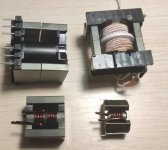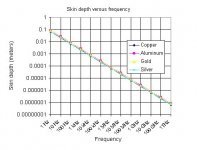Hope the GaN with the 3251 or 3255 is all win.
Got my interest.
ALot going on in that board.... Amazing.
Dr. you are like my dream maker. 😀
Got my interest.
ALot going on in that board.... Amazing.
Dr. you are like my dream maker. 😀
drMordor, is there an article describing the feedback method that you used. I am an Electrical Engineer and would love to read about it. Thanks.
NoCan there be skin effect in the inductor wire?
Audio frequency inductor current.
For comparison
On the left is a transformer and an inductor for GaN, on the right for TPA3255
Power Transformer N87 Material, I assume your maximum frequency for LLC is below 100KHz...
There is always some high frequency current through these inductors which is the reason for heating up inductors found on al cheapo class d-amps. Most of the losses are due to core material, skin and proximity effects being less dominant.No
Audio frequency inductor current.
116-148 kHz, max temperature ~60
This is possible yes as frequency is not constant.
The skin effect loss in the amplifier output filter Inductor at 20kHz is not significant compared to core loss.
At 20kHz, the skin depth in copper wire is about 0.46mm, at 5 times the radius this would be 4.6mm. The flat wire wound on the core has even lower skin loss than round wire.
This is interesting to consider, that even at 60Hz one needs to pay attention skin effect for some applications, like large mains power distribution: Microwaves101 | Skin Depth
"At 60 Hertz, no matter what the conductor, the skin depth is about 1 centimeter. That means that a power line 10 centimeters in diameter will satisfy the "five skin depths" rule (radius is 5 centimeters). Bigger than that and you are wasting copper. So to decrease losses on long high-tension runs, power companies sometimes hang double, and even triple wires for each power phase."
Skin Depth Calculator: Skin effect depth Calculator
At 20kHz, the skin depth in copper wire is about 0.46mm, at 5 times the radius this would be 4.6mm. The flat wire wound on the core has even lower skin loss than round wire.
This is interesting to consider, that even at 60Hz one needs to pay attention skin effect for some applications, like large mains power distribution: Microwaves101 | Skin Depth
"At 60 Hertz, no matter what the conductor, the skin depth is about 1 centimeter. That means that a power line 10 centimeters in diameter will satisfy the "five skin depths" rule (radius is 5 centimeters). Bigger than that and you are wasting copper. So to decrease losses on long high-tension runs, power companies sometimes hang double, and even triple wires for each power phase."
Skin Depth Calculator: Skin effect depth Calculator
Attachments
116-148 kHz, max temperature ~60
So this refers to a low noise resonant LLC ZVS SMPS?
Also, the LLC operation is using spread spectrum this reduces core loss significantly. 150KHz N87 material is not made for this. ~100KHz(max)
Never did I see spread spectrum applied to LLC. And not for loss reduction but EM-noise peak flattening if at all.
- Home
- Amplifiers
- Class D
- My new project: GaN amp and LLC+SinchroRec PSU


